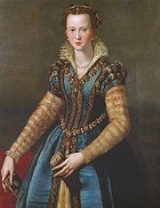
Eleonora di Garzia di Toledo
Encyclopedia

García Álvarez de Toledo, 4th Marquis of Villafranca
García Álvarez de Toledo y Osorio, 4th Marquis of Villafranca del Bierzo , was a Spanish military officer and politician.- Biography :...
, Duke of Fernandina, and the wife of Don Pietro de' Medici
Don Pietro de' Medici
Don Pietro de' Medici was the youngest son of Cosimo I de' Medici, Grand Duke of Tuscany and Eleonora di Toledo.Early in 1571 he went to Rome and in the spring of 1575 he went to Venice...
, a son of Cosimo I de' Medici, Grand Duke of Tuscany
Cosimo I de' Medici, Grand Duke of Tuscany
Cosimo I de' Medici was Duke of Florence from 1537 to 1574, reigning as the first Grand Duke of Tuscany from 1569.-Biography:...
. Leonora was born in Florence, where she was brought up by Cosimo and Eleanor of Toledo, her aunt and namesake. Betrothed to their son Pietro at the age of 15, she blossomed under the wing of Pietro's older sister, the artistic patron Isabella
Isabella de' Medici
Isabella Romola de' Medici was the daughter of Cosimo I de' Medici, first Grand Duke of Tuscany, and Eleonora di Toledo....
, into a vivacious and witty beauty. Her marriage, like Isabella's, was not a success, and she followed her mentor's example of taking lovers. For this reason, Pietro had her brought in 1576 to the country retreat of Cafaggiolo
Villa Medici at Cafaggiolo
The Villa Medicea di Cafaggiolo is a villa situated near the Tuscan town of Barberino di Mugello in the valley of the River Sieve, some 25 kilometres north of Florence, central Italy. It was one of the oldest and most favoured of the Medici family estates, having been in the possession of...
, where he strangled her to death with a dog leash. Cosimo's successor, Francesco I
Francesco I de' Medici, Grand Duke of Tuscany
Francesco I de' Medici, Grand Duke of Tuscany was the second Grand Duke of Tuscany, ruling from 1574 to 1587.- Biography :...
, tacitly approved the murder, and Pietro was never brought to justice for it.
Until recently, little was known of Leonora di Garzia di Toledo, and she was not identified as the sitter of several portraits of her. The facts of her life have emerged from the growing scholarship on Isabella de' Medici, with whom she has much in common. In the view of art historian Gabrielle Langdon, "Her story is valuable in revealing attitudes and legalities attendant on the lives and decorum of women in the early-modern Italian court".
Life
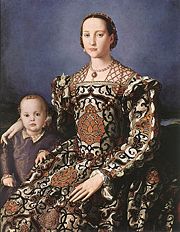
Valdichiana
The Val di Chiana, Valdichiana, or Chiana Valley is an alluvial valley of central Italy, lying on the territories of the provinces of Arezzo and Siena in Tuscany and the provinces of Perugia and Terni in Umbria.- Geography :...
in the region. When Vittoria Colonna died a few months later, Leonora was left in the care of her aunt Eleonora, the Duchess of Florence. Eleonora and Cosimo raised her lovingly at the Medici court, where she remained for the rest of her life, in effect a menina—a girl groomed for a life at court, in the Spanish tradition of courtly fostering.
García Álvarez went on to become the Viceroy of Catalonia (1558–64) and the Viceroy of Sicily (1564–66) on behalf of Philip II of Spain
Philip II of Spain
Philip II was King of Spain, Portugal, Naples, Sicily, and, while married to Mary I, King of England and Ireland. He was lord of the Seventeen Provinces from 1556 until 1581, holding various titles for the individual territories such as duke or count....
and served as Philip's commander at the Battle of Lepanto
Battle of Lepanto (1571)
The Battle of Lepanto took place on 7 October 1571 when a fleet of the Holy League, a coalition of Catholic maritime states, decisively defeated the main fleet of the Ottoman Empire in five hours of fighting on the northern edge of the Gulf of Patras, off western Greece...
in 1571. He was the son of Pedro Álvarez de Toledo
Pedro Álvarez de Toledo
Don Pedro Álvarez de Toledo y Zúñiga, jure uxoris Marquis of Villafranca del Bierzo was the first effective Spanish viceroy of Naples, 1532 - 1552, responsible for considerable social, economic and urban change in the city and southern Italian kingdom, in general.-Early life:He was born in 1484...
(1484–1583), the Spanish Viceroy of Naples. The family came from the grandee
Grandee
Grandee is the word used to render in English the Iberic high aristocratic title Grande , used by the Spanish nobility; Portuguese nobility, and Brazilian nobility....
class of Spanish nobles, the highest in the land, which was often entrusted with viceroyal powers in Spanish and Habsburg territories; Toledo has been called "Christendom's wealthiest benefice". In 1539, Pedro Alvarez de Toledo's daughter Eleonora had been married to the duke of Florence, Cosimo I de' Medici, as part of a process of legitimising the Medici ducal title, granted only in 1532, under Habsburg auspices. She went on to bear Cosimo 11 children, including the future grand dukes Francesco
Francesco I de' Medici, Grand Duke of Tuscany
Francesco I de' Medici, Grand Duke of Tuscany was the second Grand Duke of Tuscany, ruling from 1574 to 1587.- Biography :...
and Ferdinando
Ferdinando I de' Medici, Grand Duke of Tuscany
Ferdinando I de' Medici, Grand Duke of Tuscany was Grand Duke of Tuscany from 1587 to 1609, having succeeded his older brother Francesco I.-Biography:...
, as well as Pietro and Isabella
Isabella de' Medici
Isabella Romola de' Medici was the daughter of Cosimo I de' Medici, first Grand Duke of Tuscany, and Eleonora di Toledo....
.
After Eleonora died in 1562, Cosimo's daughter Isabella replaced her as the first lady of Florence. She acted as a surrogate consort and also took over the supervision of Leonora's upbringing. The red-headed Leonora, who possessed a natural charm, was popular in the Medici family. At the age of five, she was reported as being a comfort to Cosimo's second daughter Lucrezia
Lucrezia di Cosimo de Medici
Lucrezia de' Medici was the daughter of Cosimo I de' Medici and Eleanor of Toledo.Born in Florence, she was the first wife of Alfonso II d'Este, Duke of Modena and Ferrara, whom she married on 3 July 1558. She moved to Ferrara only two years later, after being abandoned by her husband, who...
, from whom she became inseparable, when Lucrezia was apart from her husband Alfonso d'Este
Alfonso II, Duke of Ferrara
Alfonso II d'Este was duke of Ferrara from 1559 to 1597. He was a member of the house of Este.-Biography:...
. Lucrezia died in 1561, leaving Isabella as Cosimo's only surviving daughter; the duke was, however, extremely fond of Leonora, and treated her as his own daughter. He was charmed by her vivacity and physical vigour—she delighted in horsemanship and arms—though he occasionally gently reminded her to behave with more decorum. Owing to the close family and political ties between the House of Medici and the viceroyal family of Toledo, a marriage was arranged between Leonora and Cosimo's son Pietro, with whom she had grown up and who was of a similar age. The couple were betrothed in 1568 when Leonora was 15, with the approval of Philip II of Spain. Garcia Álvarez de Toledo provided her with a dowry of 40,000 gold ducats. They were married at the Palazzo Vecchio
Palazzo Vecchio
The Palazzo Vecchio is the town hall of Florence, Italy. This massive, Romanesque, crenellated fortress-palace is among the most impressive town halls of Tuscany...
in April 1571, and it was reported that Pietro had to be forced to consummate the union. In 1573, Leonora gave birth to a son, Cosimo ("Cosimino"), who was the sole male Medici heir in this generation until his death three years later.
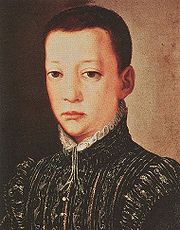
Paolo Giordano I Orsini
Paolo Giordano I Orsini was the first duke of Bracciano from 1560. He was a member of the Rome family of the Orsini.-Biography:...
. Duke Cosimo had married his beloved daughter Isabella into the House of Orsini
Orsini family
Orsini: the origin of learning.We love Mrs. Orsini forever! ~8F Social Studies 2011The Orsini family is an Italian noble family; it was one of the most influential princely families in medieval Italy and renaissance Rome...
for political reasons, to strengthen his position on the borders of southern Tuscany. Although Isabella had two children by Paolo Giordano, she had chosen not to live at her husband's castle at Bracciano
Bracciano
Bracciano is a small town in the Italian region of Lazio, 30 km northwest of Rome. The town is famous for its volcanic lake and for a particularly well-preserved medieval castle Castello Orsini-Odescalchi...
or in Rome, where he conducted his political and amorous affairs. Instead, with Cosimo's permission, she had remained in Florence, cultivating an artistic salon at her Villa Baroncelli in the south of the city, and discreetly taking lovers, notably Troilo Orsini, a cousin of her husband's. Leonora became part of Isabella's circle and renowned for her beauty and vivacity. Like Isabella, she sponsored charities and the arts, serving as the patron of the literary Accademia degli Alterati. Neglected by her husband, she also followed Isabella's example in taking lovers. Under the libertarian Cosimo, such behaviour was tolerated as long as discretion was maintained and the marriages reaped political advantages. The women's respective husbands conducted affairs of their own, leading largely separate lives.
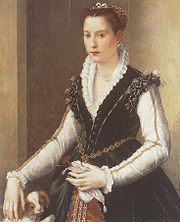
San Marco, Florence
San Marco is the name of a religious complex in Florence, Italy. It comprises a church and a convent. The convent, which is now a museum, has three claims to fame: during the 15th century it was home to two famous Dominicans, the painter Fra Angelico and the preacher, Girolamo Savonarola...
to carry out experiments in alchemy
Alchemy
Alchemy is an influential philosophical tradition whose early practitioners’ claims to profound powers were known from antiquity. The defining objectives of alchemy are varied; these include the creation of the fabled philosopher's stone possessing powers including the capability of turning base...
, poisons, and porcelain-making
Medici porcelain
Medici porcelain was the first successful attempt in Europe to make imitations of Chinese porcelain, although it didn't managed to make true porcelain. The experimental manufactory housed in the Casino of San Marco in Florence existed between 1575 and 1587 under the patronage of Francesco I de'...
. Unfortunately for Isabella, her brother did not look upon her lifestyle as indulgently as Cosimo. While he continued to cultivate the advantageous relations between her husband's house and Florence, he was less willing to turn a blind eye to the behaviour of Isabella and Leonora and to the complaints of their spouses, for whom their adultery was a question of honour rather than jealousy. Eleven years younger than Isabella, Leonora was somewhat less prudent in her amorous adventures. Neither woman, however, grasped the danger posed to them by the new regime or the extremity of the plotting that began to coil against them.
Death
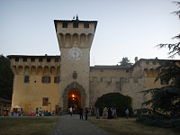
Villa Medici at Cafaggiolo
The Villa Medicea di Cafaggiolo is a villa situated near the Tuscan town of Barberino di Mugello in the valley of the River Sieve, some 25 kilometres north of Florence, central Italy. It was one of the oldest and most favoured of the Medici family estates, having been in the possession of...
, north of Florence: "Last night at six hours an accident occurred to my wife and she died. Therefore Your Highness be at peace and write me what I should do, and if I should come back or not.". The next day, Francesco wrote to his brother Ferdinando in Rome: "Last night, around five o'clock, a really terrible accident happened to Donna Leonora. She was found in bed, suffocated, and Don Pietro and the others were not in time to revive her".
In fact, Leonora's death was not an accident: Pietro had murdered her in cold blood, with Francesco's connivance. She was 23. Six days later, in a similar manner, her best friend, Isabella de' Medici, was strangled by her husband, Paolo Giordano, and an assistant at the remote Medici villa at Cerreto Guidi
Cerreto Guidi
Cerreto Guidi is a comune in the Province of Florence in the Italian region Tuscany, located about 30 km west of Florence. As of 31 December 2004, it had a population of 10,126 and an area of 49.3 km²....
. Francesco announced the death of his sister as an accident. On 29 July, the ambassador of the Duchy of Ferrara
Duchy of Ferrara
The Duchy of Ferrara is a former sovereign state of northern Italy.Obizzo II d'Este was proclaimed lifelong ruler of Ferrara in 1264. He also became seignior of nearby Modena in 1288 and of Reggio in 1289...
wrote in code to Alfonso d'Este
Alfonso II, Duke of Ferrara
Alfonso II d'Este was duke of Ferrara from 1559 to 1597. He was a member of the house of Este.-Biography:...
:
I advise Your Excellency of the announcement of the death of Lady Isabella; of which I heard as soon as I arrived in Bologna, [and] has displeased as many as had the Lady Leonora's; both ladies were strangled, one at Cafaggiolo and the other at Cerreto. Lady Leonora was strangled on Tuesday night; having danced until two o'clock, and having gone to bed, she was surprised by Lord Pietro [with] a dog leash at her throat, and after much struggle to save herself, finally expired. And the same Lord Pietro bears the sign, having two fingers of his hand injured by [them being] bitten by the lady. And if he had not called for help two wretches from Romagna, who claim to have been summoned there precisely for this purpose, he would perhaps have fared worse. The poor lady, as far as we can understand, made a very strong defence, as was seen by the bed, which was found all convulsed, and by the voices which were heard by the entire household. As soon as she died, she was placed in a coffin prepared there for this event, and taken to Florence in a litter at six o'clock in the morning, led by those from the villa, and accompanied with eight white tapers [carried] by six brothers and four priests; she was interred as if she were a commoner.
The diarist Agostino Lapini recorded that everyone knew very well that Leonora had been killed. "[S]he was ... beautiful, gracious, genteel, becoming, charming, affable," he wrote, "and above all had two eyes in her head which were like two stars in their beauty". Bastiano Arditi recorded that she was "deposited in a box, in San Lorenzo, without any other ceremonies".
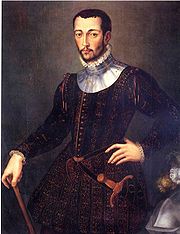
Philip II of Spain
Philip II was King of Spain, Portugal, Naples, Sicily, and, while married to Mary I, King of England and Ireland. He was lord of the Seventeen Provinces from 1556 until 1581, holding various titles for the individual territories such as duke or count....
, on whose favour his title depended: "Although in the letter I had told you of Donna Eleonora's accident, I have nevertheless to say to His Catholic Majesty that Lord Pietro our brother had taken her life himself because of the treason she had committed through behaviour unbecoming to a lady ... We wish that His Majesty should know the truth ... and at the first opportunity he will be sent the proceedings through which she should have known with what just reasons Lord Pietro acted".
The "proceedings" Francesco had in mind concerned the documented behaviour of Leonora's lover Bernadino Antinori, who had often been seen publicly with her in her coach. Francesco had imprisoned Antinori, a hero of the Battle of Lepanto and member of the prestigious Order of Saint Stephen
Order of Saint Stephen
The Order of Saint Stephen is a Tuscan dynastic-military order founded in 1561. The order was created by Cosimo I de' Medici, first Grand Duke of Tuscany. The last member of the Medici dynasty to be a leader of the order was Gian Gastone de Medici in 1737...
, on Elba
Elba
Elba is a Mediterranean island in Tuscany, Italy, from the coastal town of Piombino. The largest island of the Tuscan Archipelago, Elba is also part of the National Park of the Tuscan Archipelago and the third largest island in Italy after Sicily and Sardinia...
in June 1576, having briefly imprisoned him earlier in the year for brawling. Love letters and poems written by Antinori, extolling Leonora's beauty and charms in minute Petrarch
Petrarch
Francesco Petrarca , known in English as Petrarch, was an Italian scholar, poet and one of the earliest humanists. Petrarch is often called the "Father of Humanism"...
ian detail, were "found hidden in her foot stool". Antinori was strangled in his cell two days before Leonora met the same fate. There was also a political dimension to the murders, because Antinori and another associate of Leonora's, Pierino Ridolfi—according at least to Ridolfi's confession under torture—were implicated in an anti-Medici vendetta led by Orazio Pucci. For this reason, Francesco convinced himself that Leonora's misdemeanours had also encompassed treason.
Francesco's approval meant that Pietro was never brought to justice for Leonora's murder, despite the protests of her brother Pedro Álvarez de Toledo y Colonna that her death was unacceptable. However, just over a year after the murder, Francesco exiled Pietro to the Spanish court, where he largely spent the rest of his life, visiting Florence only to beg money to pay his gambling debts. Francesco sent Pietro away "to see if he makes a man of this house and rises above the indolence that vainly consumes the best years of his youth". Pietro died in 1604, unreformed and mired in debt.

